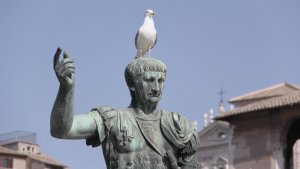Do Leaders Really Make Independent Decisions?
Julius Caesar’s Crossing of the Rubicon Holds a Lesson.

We tend to think of high-stakes leadership decisions as the product of a single mind at the top — a moment of clarity when the leader weighs up the options, consults data, listens to counsel, and finally chooses a path. But how independent are those decisions, really?
Julius Caesar’s decision to cross the river Rubicon in 49 BC — an act that sparked civil war and ultimately reshaped Rome into an empire — is often held up as a bold, autonomous act of leadership. It’s the archetype of the “point of no return.” Yet, the story behind that decision is far more complex — and far more relevant to modern leadership than we might assume.
Leadership in a Power Struggle
During the 50s BC, the coalition between Caesar, Crassus, and Pompey, known as the Triumvirate, held sway over Rome and its empire. A majority of the Senate, Rome’s traditional centre of power, was becoming increasingly frustrated by the Triumvirate's influence, which gobbled up jobs, lucrative assignments, and power for themselves and their followers.
When Crassus died in 54 BC, these senators saw an opportunity for a comeback. They planned to deal with Caesar first and get rid of Pompey next in order to return to the traditional oligarchy without overbearing individuals. A precarious balance of power, preventing one ambitious member from overshadowing the other two, held the Triumvirate together. Now, the competition between the two remaining members could break the coalition. For a couple of years Caesar’s and Pompey’s cooperation endured, but then the pull from the Senate, offering Pompey the status and recognition he longed for became too strong.
While Caesar conquered Gaul, his power base in Rome began to erode. The Triumvirate was gone. His daughter Julia — also Pompey's wife — had acted as a crucial bridge between the two men. Her death severed that connection. His mother, Aurelia, a seasoned behind-the-scenes influencer, also passed. And Clodius, a key political ally, was killed in street violence.
Caesar, coming to the end of his assignment, wanted another run at consul, Rome’s highest office. But to do that, he needed an exception to stand for election in absentia. (To prevent a military coup, the constitution forbade military commanders from entering the city.) At first, it looked possible. Then political tides turned. The Senate revoked the exception. Next followed a back-and-forth between Caesar in Gaul and the Senate in Rome about this issue. Compromises were floated. None stuck. Tensions escalated. Emboldened by the support from Pompey and frustrated by Caesar’s refusal to budge, the Senate gave Caesar an ultimatum to step down or be outlawed. Hearing this, Caesar cast the die and crossed the river into civil war.
The Role of Followers in Shaping the Leader’s Decisions
Caesar’s followership relied on social and political outsiders. From a distance in Gaul, Caesar had to rebuild his support network from scratch. He had to make do with young, ambitious, and radically anti-Senate politicians such as Curio and Marc Antony. They pleaded his cause in Rome — but dialled up the conflict — and gave him filtered feedback. Curio blatantly urged him to start a war.
Back in Gaul, Caesar’s army officers — many of whom owed their careers to him — stood to lose everything if he faltered. One of Caesar’s success factors had been the recruitment of talented individuals with a lower status who were spurned by the elite. At the same time, Caesar had incurred a most loyal officer corps thanks to delivering on his commitments. His staff, therefore, knew that Caesar listened to their requests. Finally, his followers were well aware of what Caesar, a proud person protective of his reputation, wanted to hear and didn’t want to hear.
Decision-Making Is Rarely Solitary
In the end, Caesar’s crossing of the Rubicon wasn’t just a product of ambition, competition, or pride. It became an example of how followers can convince or seduce leaders to make a decision they do not really want, leading to dramatic consequences. It was the result of a series of filtered signals, biased incentives, and a narrowing of options—the kind of subtle coercion that many modern leaders experience.
Leaders are surrounded by the voices of stakeholders, whose stakes include their interests and ambitions. Many of those voices mean well, but others come with agendas or blind spots. Even well-intentioned input can create an echo chamber. Furthermore, those who represent the leader, unless well instructed, can produce adverse effects and ill will with the other party.
What Can We Learn from Caesar?
Leadership isn’t just about being decisive. It’s about being aware of who is influencing your decisions — and how. That requires:
- Actively seeking dissenting views
- Creating space for honest feedback
- Knowing when ambition is clouding your judgement — or someone else’s
- Delegation with clear expectations regarding the “what” as well as the “how”
Paul Vanderbroeck is an executive coach and educator with a PhD in History. He is the author of Lead Like Julius Caesar Timeless Leadership Lessons from History's Most Influential Leader, (Published by Springer, 2025).
Thanks for signing up to Minutehack alerts.
Brilliant editorials heading your way soon.
Okay, Thanks!

